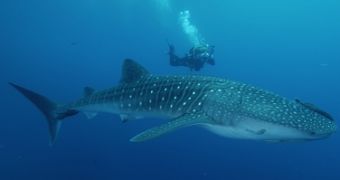Perhaps most of the things that we know about sharks come from the movies and documentaries presenting the terrible great white shark and the reef sharks. What else?
1.Generally, sharks are carnivorous, eating from sea urchins to mollusks (including squids and octopuses), sea mammals (seals, dolphins and whales), sea birds, fish and, of course, other sharks. The fossil shark Hybodus consumed belemnites (shelled squids).
There are three species of shark eating plankton and paradoxically, these are the largest known shark species: the whale shark (which is also the largest fish: 12.6 m (41.5 ft) long and 21.5 tonnes), the basking shark and the megamouth shark.
Rays and skates are just flattened sharks. In this group, the largest species is the giant manta (Manta birostris) up to 8 m (26 ft) in diameter and 3 tonnes in weight. This giant fish executes breachings up to 2 m (6.6 ft) high, and their fall on the water causes a shock wave spreading to distances of up to 1.5 km (0.9 mi).
2.Sharks can hear sounds from 2 km (1.2 mi) away. The great white shark can detect the vibrations of its prey in the water from a distance of 4.5 km (2.8 mi).
3.Reef sharks are territorial; the other species are not.
4.All sharks have internal fertilization, and, unlike most fish, the male has a penis to inseminate the female. To stimulate the female, the male grabs her pectoral fin with the teeth. The pelagic sharks (those swimming actively) are viviparous (give birth to living offspring), the bottom sharks depose eggs (are oviparous) or maintain the eggs inside till hatching (ovoviviparous).
5.In sharks giving birth to live offspring, gestation lasts 1-2 years and the number of offspring varies from 2 to tens. Inside the uterus of a 10.67 m (35.5 ft) long female whale shark, there were 300 embryos, measuring 40.64-63.5 (1.4-2.05 ft). 15 of them were alive and on the way to be born.
6.In some cases, the first embryos to hatch eat the other eggs found in the oviduct, fecundated or not, a phenomenon called oophagy (like in the great white shark, mako sharks, thresher sharks, bull shark, basking shark).
The intrauterine cannibalism can go much further: they consume developing embryos, like in sand tiger shark. The resulting offspring is large enough to be less exposed to predators (mostly to other sharks).
Usually, just two offspring are born in the case of oophagy.
7.Today, the largest predator shark is the great white shark that can reach 6.4 m (22 ft) in length and 3.2 tonnes in weight, feeding on fish, sharks, squids, marine mammals, turtles and sea birds. They can gather more individuals around whale carcasses or seal colonies.
Procarcharodon megaladon, one relative of the great white, that lived 65 million years ago, was 13 m (44 ft) long!
8.Not all the sharks are big. In fact, of the 360 described species, 50 % are under 1 m (3 ft) long, 30 % are 1-2 m (3-6 ft) long and 14 % 2-4 m (6-12 ft) long. Just 3 % (11 species) can reach length over 4 m (12 ft). The smallest shark is the pygmy ribbontail catshark (Eridacnis radcliffei) 25 cm (0.8 ft) long and 10-30 g in weight.
9.The only species of sharks living in freezing polar waters are the Greenland shark (Somniosus microcephalus) and Pacific sleeper shark (S. pacificus).
10.There are sharks entering freshwater, like the bull shark, which presents populations living in the lakes of Nicaragua and penetrating deep into the Amazon and Zambezi rivers. The river sharks of the genus Glyphis enter rivers from south Asia (Ganges, Indus, Irrawaddy), Borneo and New Guinea.
11.Sharks have high levels of urea in the blood that is important in their osmoregulation (it impedes the loss of water from the body attracted through osmosis by the sea water). This would be toxic for other vertebrates. Those living in the rivers and lakes present low levels of urea.
12.The leaver can make one fourth of the weight of a shark.
13.Meat eating sharks have bladed and serrated teeth; those feeding on plankton retain it with their gill spikes, while those eating hard shelled mollusks and crustaceans have flattened teeth.
14.Sharks can detect infinitesimal variations of the of the electric field generated by living animals due to a sixth sense determined by the ampullae of Lorenzini, special receptors located on the head and snout. These small canals, found in all fishes, are more numerous and perfected in sharks. They act like extremely sensitive electro-receptors that capture electric discharges no higher than 3 mV (microvolts).
15.Shark teeth are replaced at each 15 days.

 14 DAY TRIAL //
14 DAY TRIAL //